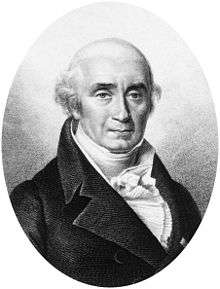Marc-Auguste Pictet
Marc-Auguste Pictet (French: [piktɛ]; July 23, 1752 – April 19, 1825) was a scientific journalist and an experimental natural philosopher (physicist, chemist, meteorologist, astronomer) born in Geneva, Republic of Geneva.

Pictet's main contribution to learning was his editing of the Bibliothèque britannique (1796-1815), devoted to the diffusion on the Continent of scientific knowledge produced in Great Britain. His own scientific research was leaning towards physical sciences, especially calorimetry, but also astronomy,[1] geology, meteorology and technology, especially chronometry and the manufacture of fine earthenware.[2]
Life
He was born on 23 July 1752, the son of Charles Pictet, a military officer serving in the mercenary troops of Netherlands, and his wife, Marie Dunant.[3]
Marc-Auguste studied natural philosophy and law at the Geneva Academy and qualified as a lawyer in 1774. After one year in England (1775–76), he became assistant to Jacques-André Mallet at the Geneva Observatory and took an interest in meteorology and map-making. In 1778, he made his first trip around the Mont-Blanc with his master Horace-Bénédict de Saussure. In 1786, he would succeed him as professor of natural philosophy at the Academy of Geneva.[4]
By this time, he assisted Horace-Benedict de Saussure with an experiment which demonstrated that (what we call now) infra-red radiation exists, and in a follow up experiment, named Pictet's experiment by Count Rumford, demonstrated that cold can be reflected by focussing the radiation from a flask of ice onto a thermometer using two concave mirrors.[5] The result of his experiments on heat was published in 1790 as Essai sur le feu (English translation: An Essay on Fire, 1791). At this time he had already converted to Lavoisier's chemistry.
In 1791, Pictet was one of the twelve founding members of the Geneva Society of Physics and Natural History. In 1796, he, his younger brother Charles, and his friend Frédéric-Guillaume Maurice began editing a monthly periodical entitled Bibliothèque Britannique, which carried translations of significant scientific papers published in English by scholars such as Davy, Hall, Herschel, Leslie, Playfair, Rumford or Wollaston. It therefore covered a wide range of scientific and technical topics, as well as extracts of British literature and articles on agriculture.[6] After 1815, this periodical included other European materials (mainly French, German and Italian) and took from then on the name of Bibliothèque Universelle de Genève.
Between 1790 and 1819, Pictet was the director of the Geneva Observatory. As such, he oversaw the installation of a meteorological station, before setting up another one on Great St. Bernard mountain in the Alps (1819).
In 1815, the year Geneva adhered to the Swiss Confederation, Pictet, Henri-Albert Gosse and Jakob Samuel Wyttenbach were the main agents in the creation of the Swiss Society of Natural Sciences.
Pictet was a Fellow of the Royal Society of London and an "associé libre" of the Académie des Sciences. His expertise, relationships and correspondence network extended throughout Western Europe and as far as the United States, and Thomas Jefferson. It included hundreds of scholars.[7] He was elected a Fellow of the Royal Society of Edinburgh in 1796.[8]
The Geneva Society of Physics and Natural History offers a yearly award in history of science called the Marc-Auguste Pictet Prize. It also awards a yearly medal to "a scholar whose work is recognized as an authority in the history of science". Winners are chosen by a panel of University of Geneva professors and field experts.
Family
In 1766 he married Susanne Francoise Turrettini (d.1811).
See also
- Jean Rilliet, Jean Cassaigneau, Marc-Auguste Pictet ou le rendez-vous de l’Europe universelle, 1752-1825, Genève, Slatkine, 1995 (ISBN 9782051013475) (OCLC 36520875) 784 p.
- Jean-Daniel Candaux, Histoire de la famille Pictet 1474-1974, Genève, Braillard, 1974.
References
- In honour to his researches, a crater of the Moon has been called by his name.
- René Sigrist & Didier Grange, La faïencerie des Pâquis. Histoire d'une expérience industrielle, 1786-1796, Genève, Passé-Présent, 1995.
- Biographical Index of Former Fellows of the Royal Society of Edinburgh 1783–2002 (PDF). The Royal Society of Edinburgh. July 2006. ISBN 0 902 198 84 X. Archived from the original (PDF) on 2016-03-04. Retrieved 2017-12-24.
- Jean-Daniel Candaux, Histoire de la famille Pictet, 1474-1974, Genève, Braillard, 1974
- Evans, James; Popp, Brian (1985). "Pictet's experiment: The apparent radiation and reflection of cold" (PDF). American Journal of Physics. 53 (8): 737–753. Archived from the original (PDF) on August 3, 2020.
- David M. Bickerton, Marc-Auguste and Charles Pictet, the "Bibliothèque britannique" (1796-1815) and the dissemination of British literature and science on the Continent, Geneva, Slatkine, 1986.
- René Sigrist (ed.), Marc-Auguste Pictet, Correspondence : sciences et techniques, Geneva, Slatkine, 1996-2004 (4 vols).
- Biographical Index of Former Fellows of the Royal Society of Edinburgh 1783–2002 (PDF). The Royal Society of Edinburgh. July 2006. ISBN 0 902 198 84 X. Archived from the original (PDF) on 2016-03-04. Retrieved 2017-12-24.
External links
- Marc-Auguste Pictet Prize
- Marc-Auguste Pictet in German, French and Italian in the online Historical Dictionary of Switzerland.
- Geneva Society of Physics and Natural History
- Pictet Family Archives (in French) — includes a family tree since 1344
- List of works by James Pradier